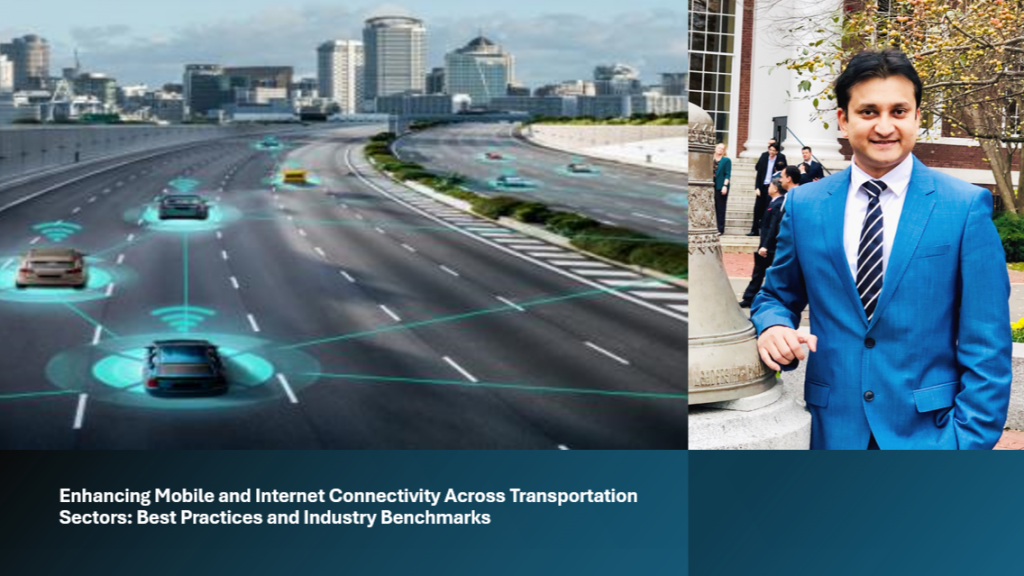
Reliable mobile and internet connectivity across rail, highways, and naval routes is essential for seamless communication, safety, and efficiency. It enables real-time navigation, emergency response, and uninterrupted internet access for passengers, enhancing their travel experience. Businesses benefit from improved logistics, real-time tracking, and smart infrastructure, optimizing operations and reducing delays. Additionally, strong connectivity supports remote work, digital transactions, and the growth of autonomous and AI-driven transport systems. As mobility advances, investing in robust connectivity is crucial for safer, smarter, and more efficient transportation networks.
Let’s explore best practices and industry benchmarks for optimizing network performance in these sectors, identifying key performance indicators (KPIs) and global strategies for infrastructure improvement on a global scale.
1. Rail Mobility: Challenges and Solutions
Best Practices:
- Hybrid Connectivity Solutions: Integration of terrestrial (5G) and satellite systems ensures uninterrupted service in areas with limited infrastructure.
- 5G Rail Corridors: Dedicated 5G networks along railway tracks, such as the European Union’s initiatives, improve service continuity across borders.
- Millimeter-Wave (mmWave) Technology: Utilizing the 57-71 GHz spectrum enhances data speeds by up to 20 times compared to traditional networks.
- Advanced Antenna Systems: Multi-SIM antennas enhance signal reliability by connecting to multiple networks simultaneously.
Industry Benchmarks:
- Data Throughput: Download speeds exceeding 500 Mbps are considered optimal. Deutsche Bahn’s Advanced Train Lab in Germany recorded speeds up to 553 Mbps with 5G and satellite integration.
- Latency: Less than 50 ms is required for real-time applications.
- Handover Success Rate: Exceeding 99% ensures seamless connectivity during high-speed travel.
Case Studies:
- Deutsche Bahn’s Advanced Train Lab (Germany): In 2023, Deutsche Bahn (DB) conducted trials combining 5G networks with satellite connections, including Elon Musk’s Starlink network. This integration achieved exceptional onboard Wi-Fi speeds of up to 553 Mbps, significantly surpassing typical household internet speeds.
- ScotRail’s Onboard Wi-Fi (Scotland): ScotRail offers complimentary onboard Wi-Fi; however, recent assessments revealed challenges in speed and reliability, particularly in rural areas. During tests, speeds dropped to as low as 474 Kbps, highlighting the need for infrastructure improvements to meet passenger expectations.
2. Highway Mobility: Network Performance Optimization
Best Practices:
- Dense Network of Base Stations: Deploying towers at regular intervals ensures continuous rural and urban coverage.
- Comprehensive 5G Coverage: Expanding 5G along highways supports applications such as autonomous driving and smart transportation.
- Collaborative Infrastructure Sharing: Mobile Network Operators (MNOs) can reduce costs and accelerate coverage expansion by sharing assets.
- Edge Computing Deployment: Reducing latency and processing data closer to end-users enhances network efficiency.
Industry Benchmarks:
- Signal Strength: Maintain a minimum of -85 dBm for reliable connections.
- Data Throughput: At least 25 Mbps ensures seamless mobile experience.
- Latency: Less than 30 ms for optimal real-time navigation and V2X (Vehicle-to-Everything) communication.
- Handover Delay: Below 150 ms prevents disruptions during high-speed travel.
- Network Availability: 99.9% uptime minimizes dropped connections.
Case Studies:
- T-Mobile’s Eastern Corridor Coverage (USA): Along the U.S. Eastern Corridor rail routes, T-Mobile has demonstrated superior data speeds compared to other operators. However, 5G coverage remains inconsistent, with certain segments experiencing no connectivity, underscoring the need for continuous infrastructure development.
- IoT Applications for Highway-Rail Grade Crossings: The integration of Internet of Things (IoT) technologies in transportation has shown potential to reduce accidents at highway-rail grade crossings, enhancing overall safety and efficiency.
3. Naval Mobility: Connectivity Beyond Shores
Best Practices:
- Satellite Integration: Low Earth Orbit (LEO) satellite systems provide coverage in remote maritime regions.
- Hybrid Connectivity Solutions: Combining satellite and terrestrial networks ensures consistent service.
- Resilient Network Design: Robust maritime communication equipment withstands extreme weather conditions.
Industry Benchmarks:
- Coverage Availability: Over 99% in coastal and open sea areas.
- Data Throughput: Consistent speeds of at least 10 Mbps for onboard communication and IoT applications.
- Latency: Below 100 ms to enable effective maritime communication.
- Network Coverage Range: Connectivity up to 100 nautical miles offshore supports maritime operations.
Case Studies:
- Satellite Integration in Maritime Communication: The adoption of Low Earth Orbit (LEO) satellite systems, such as Starlink, has enhanced connectivity for maritime vessels, providing more reliable and faster internet access even in remote ocean regions.
Key Performance Indicators (KPIs) for Mobile & Internet Coverage
Rail Mobility
- Coverage Availability (%): Time with stable connectivity.
- Handover Success Rate (%): Successful tower transitions.
- Data Throughput (Mbps): Download/upload speed.
- Latency (ms): Time delay affecting real-time applications.
- Packet Loss (%): Data transmission reliability.
Highway Mobility
- Signal Strength (dBm): Measured network quality.
- Call Setup Success Rate (%): Percentage of successful call initiations.
- Average Data Speed (Mbps): Internet speed consistency.
- Dropped Connection Rate (%): Frequency of disconnections.
- Handover Delay (ms): Time taken for network transitions.
Naval Mobility
- Network Coverage Range (km): Distance from shore with stable signal.
- Satellite vs. Cellular Usage (%): Distribution of network reliance.
- Voice Call Quality (MOS Score): Measured voice clarity.
- Weather Impact Resistance (%): Network stability under adverse conditions.
Global Considerations and Future Directions
- Data Collection & Analysis: Countries like Australia have initiated nationwide audits to improve rural and remote mobile coverage.
- Infrastructure Investment: Modernizing network infrastructure is crucial for bridging coverage gaps and meeting rising data demands.
- Policy and Regulation: Governments should simplify planning processes and incentivize infrastructure development for faster deployment of advanced connectivity solutions.
Conclusion
By adhering to best practices and meeting industry benchmarks, mobile and internet coverage across transportation networks can be significantly improved. Advancements in technology, infrastructure investment, and regulatory support will drive the future of seamless, high-performance connectivity across rail, highway, and naval mobility worldwide.














Leave a comment